Loading Data…
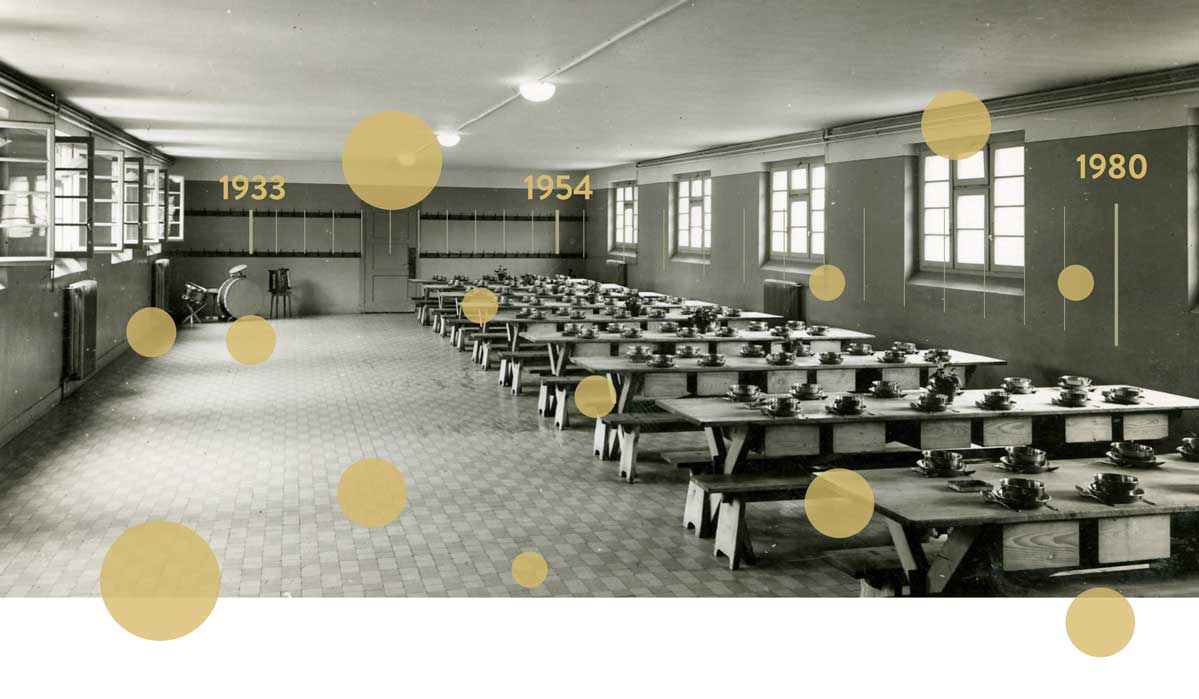
The characterisation of individuals as "indolent", "drunkards" or "dissolute" served in numerous Swiss statutes as the starting point – and the justification – for proceedings leading to their placement in administrative detention. This was a compulsory welfare measure that provided municipal and cantonal authorities with a very specific instrument for institutionalising individuals whose behaviour was considered "conspicuous" for disciplinary or re-education purposes. Often there was no cantonal court involved at any stage of the decision-making process. The decision to detain an individual was thus purely administrative and violated the fundamental constitutional principle of separation of powers. The prevailing attitude at the time was that the individuals in question needed to be removed from society, held in a closed environment and rehabilitated, before being released and re-integrated into the general community. The municipalities and the cantons developed various strategies for achieving this goal of "protecting society". Because of the costs involved in the construction and maintenance of such institutions as cantonal prisons, workhouses and psychiatric facilities, not all cantons were willing or able to do so on their own territory. As a result, the authorities of one canton often ordered the detention of their own citizens in institutions located in other cantons, thus helping to ensure high occupancy rates. This was a major factor in the evolution of what were termed multi-functional institutions, where condemned criminals and administrative detainees were housed together under one roof.
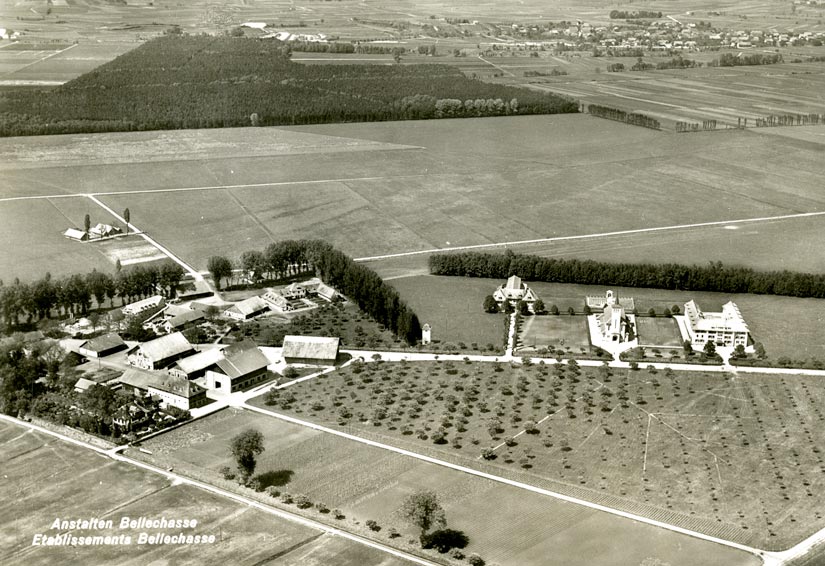
Img. 1.1 – State Archive of the Canton of Fribourg (StAF), EB Div Photos 10 I, Bellechasse, aerial photography, 1948, Section 1, image 3 : «general view». [Photographer: Swissair Lufbild, published by O. Wyrsch, Wabern b. Bern]
One of the aims of the Independent Expert Commission (IEC) is to produce quantitative studies of the institutional landscape that will provide a more precise picture of the facilities that were used and the authorities that issued administrative detention orders. The charting of this institutional topography was facilitated by the surviving directories from the year 1933, from the 1940s, and from the years 1954, 1965 and 1980. The information they contain includes the names and locations of all the relevant institutions, together with key data concerning their purpose, maximum capacity, and the responsible authorities. When working with historical sources of this kind, it is necessary to keep in mind that they were prepared by different authors and from differing perspectives. With the help of DensityDesign Research Lab, the data collected was converted into interactive maps and visualisations that allow for a more detailed understanding of the temporal and spatial dimensions of administrative detention.
The narrative is presented in four sections. To begin, we describe the content and the historical context of the directories, including the different points on which they each focused. The data is then charted on maps and collated based on various factors such as facility types, institutional capacity, and gender distribution. In the next section, it is possible to freely choose different sets of variables, in order to arrive at a more precise characterisation of the various facility types. The final section of the narrative describes the procedures used by the authorities for ordering administrative detention – taking as examples the Canton of Fribourg and the Bellechasse correctional facilities – and gives a picture of the network that developed between the authorities of different cantons. Each visualisation offers the possibility of freely choosing between various data years and categories. Additional information appears when the viewer clicks on the various elements of the visualisations. A comprehensive glossary has also been included.
All of the raw data and the documentation for each visualisation is available on the Open Data Swiss Portal, follow this link to access them: opendata.swiss/de/dataset/anstaltstopografie.
On that page it is possible to retrieve the following:
The interactive glossaries can be accessed through the following addresses:
The timeline covers the period from 1930 to 1980. Our intent is to provide an overview of developments in the social history of Switzerland during the period under study and to chart also the relevant legislative developments. The simultaneous display of events and sources at these three levels helps to situate the phenomenon of administrative detention in a larger historical context.
The chart represents major events that happened between 1930 and 1990. Move your mouse cursor over any element to learn name and date of the event, click on it to reveal further information in the side panel.
Timeline of major events
Social history: the introduction of social security measures in the 1940s (Old Age and Survivor Benefits Insurance, Disability Insurance, Family Allowances, Unemployment Insurance) – measures still in effect today – and Switzerland's ratification of the European Convention on Human Rights in 1974, had an important influence on the decisions taken by the authorities, as they offered viable alternatives for dealing with poverty and so-called social deviance.
Legislation: this level shows the federal and cantonal laws that were of relevance to administrative detention measures. It makes clear the extent to which the use of administrative detention was influenced by cantonal structures. At the same time, a study of the wording of the laws reveals that the term "administrative detention" was only rarely employed; very often character descriptions are used for purposes of categorisation (e.g. indolent, dissolute, drunkard).
Visualisation 1.2 – Directories and detention facilities
Open in a separate window
This section presents the available historical sources; it describes the quality of the sources and the ways they can be of use. The information on which the charts are based was gathered from five directories that list the facilities and institutions that were used for correctional purposes and the execution of administrative detention orders at different periods. The directories were compiled at different times and by different authors. Common to all of them is that they cover the whole of Switzerland. They are comparable in the amount of detail they include and, when they were compiled, they all served as guides (reference works) for the authorities that issued administrative detention orders.
The chart represents the surveyed facilities and their corresponding status year by year. scroll down to switch from this mosaic plot to a sankey diagram, click on any block or flow to reveal the list of facilities beloinging to the corresponding group in the side panel.
At the same time, however, they also vary widely in the perspectives from which they were prepared. They thus focus on different types of institutions. Three of the directories contain all of the data we needed for preparing the charts (1954, 1965, 1980). For the other two, the lists from 1933 and the 1940s, it was necessary for us to also consult other sources as well, in order to complete the information. Poorhouses are mentioned only in the first source, while the directory from 1980 is mainly limited to prison facilities. This illustrates one of the weaknesses of these sources, since they do not always provide a full picture of the situation. Poorhouses, for example, continued to play an important role for dealing with poverty among the elderly and for the administrative internment of persons of advanced age.
Directories and detention facilities
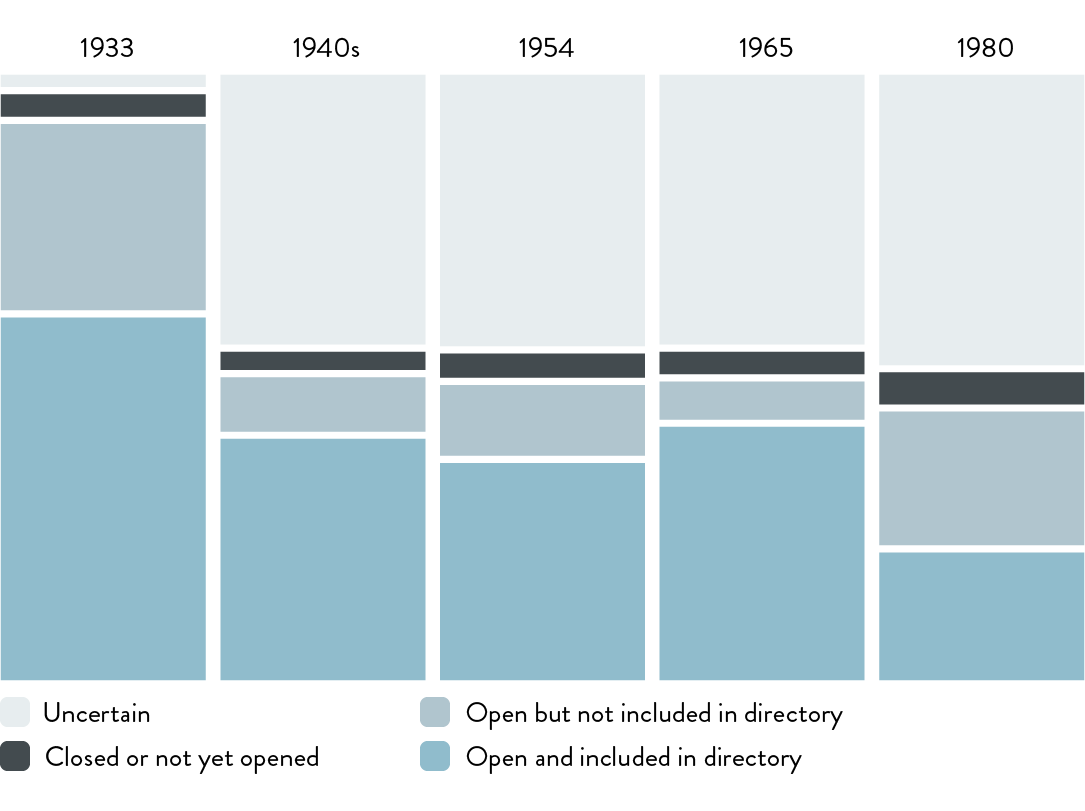
The mosaic diagramme is complemented by the Sankey diagramme shown below, which illustrates the shift in the perspective taken by the directories over the period of time they cover. A total of 648 institutions are listed in the five directories, although not all of them necessarily appear in each individual survey (directory). How many of the institutions were still in operation, but not included in the respective directories? Are there gaps in the data? Another point to consider is that some of the institutions were closed over the years, while new ones were opened.
Directories and detention facilities
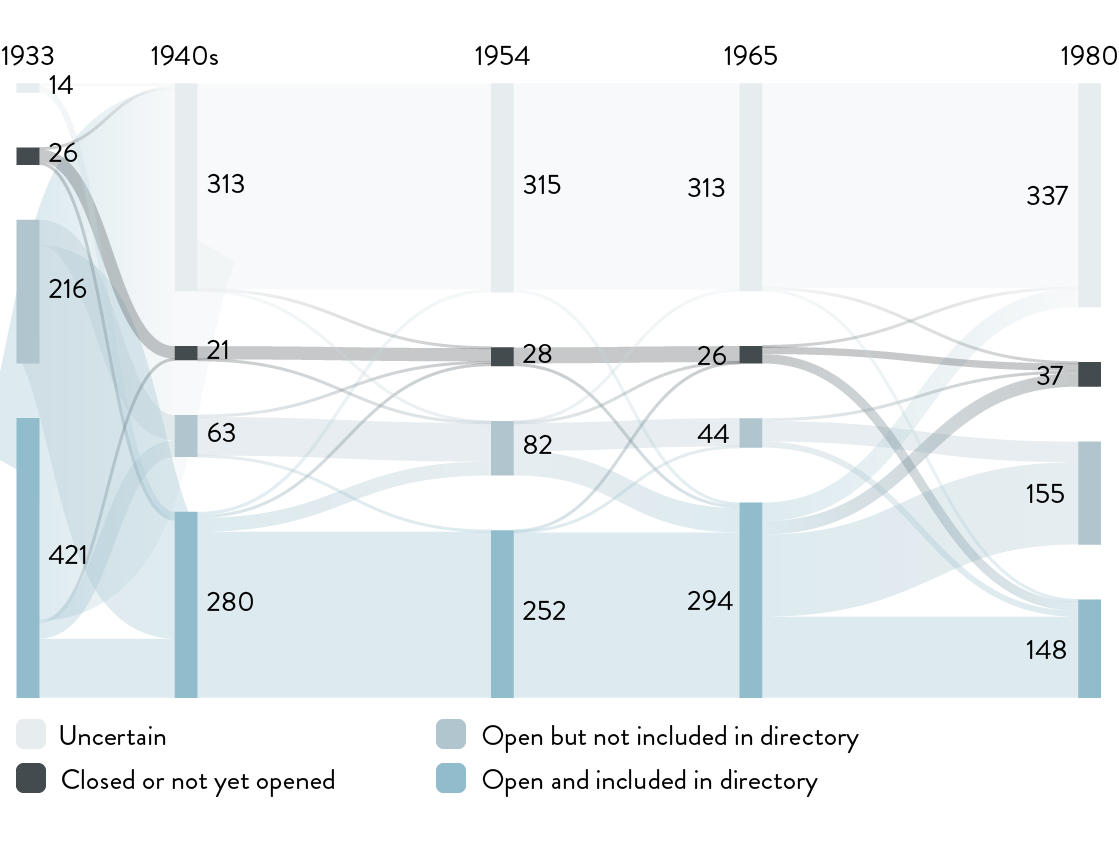
The institutions were often used to confine persons whose detention was ordered on various grounds (under criminal law, civil law, administrative detention/cantonal internment laws). The Bellechasse facilities are typical of such institutions. The Bellechasse complex included a prison, an alcohol rehabilitation facility, and a correctional labour facility.
In the chart above, facilities are grouped depending on the number of typologies of individuals they hosted. Move the mouse cursor over any element to learn name and location of facilities, click on any element to reveal further information in the side panel, such as facilities typologies. Switch between survey years by using the menu on top of the visualisation. hover on legend items to highlight corresponding elements.
Facilities purposes in 1954
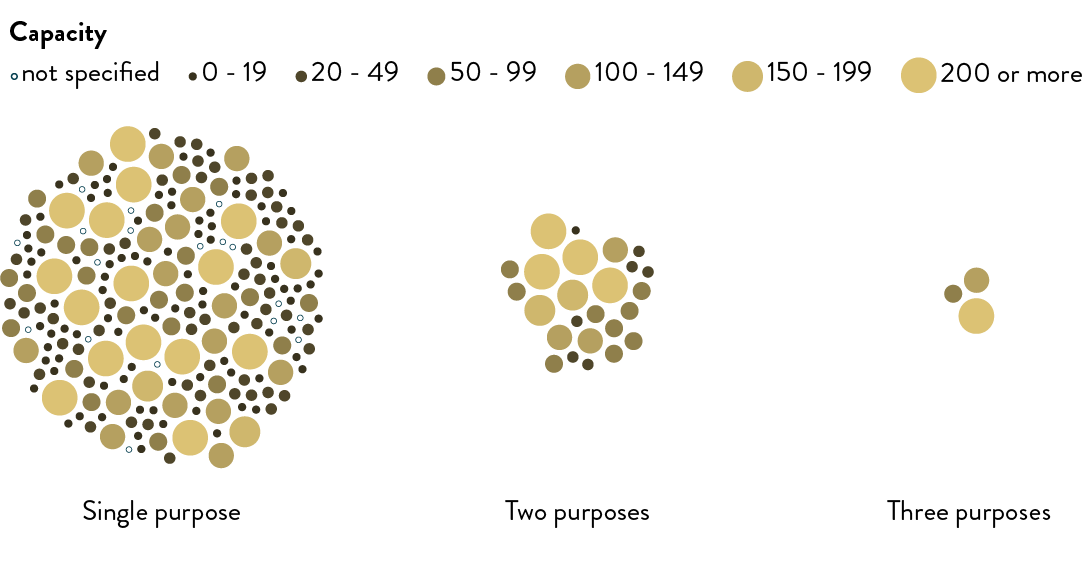
This map provides a complete overview of the 648 facilities in operation in the years indicated. It is possible to identify areas of concentration and gaps in the geographic distribution. In 19541954 for example, most of the surveyed facilities were spread all over the region known as the Swiss Plateau (or Central Plateau), with a number of main hubs. In 19651965, by contrast, many institutions are also found in urban centres such as Zurich, Basel, Bern and Geneva, but also in such rural areas as the so-called Seeland, at the foot of the Jura Mountains, as seen in the chart below.
The map beside shows all facilities regardless of their typologies or any other property. Move the mouse cursor over any element to learn name and location of facilities, click on any element to reveal further information in the side panel. Switch between survey years by using the menu on top of the visualisation.
Locations of facilities
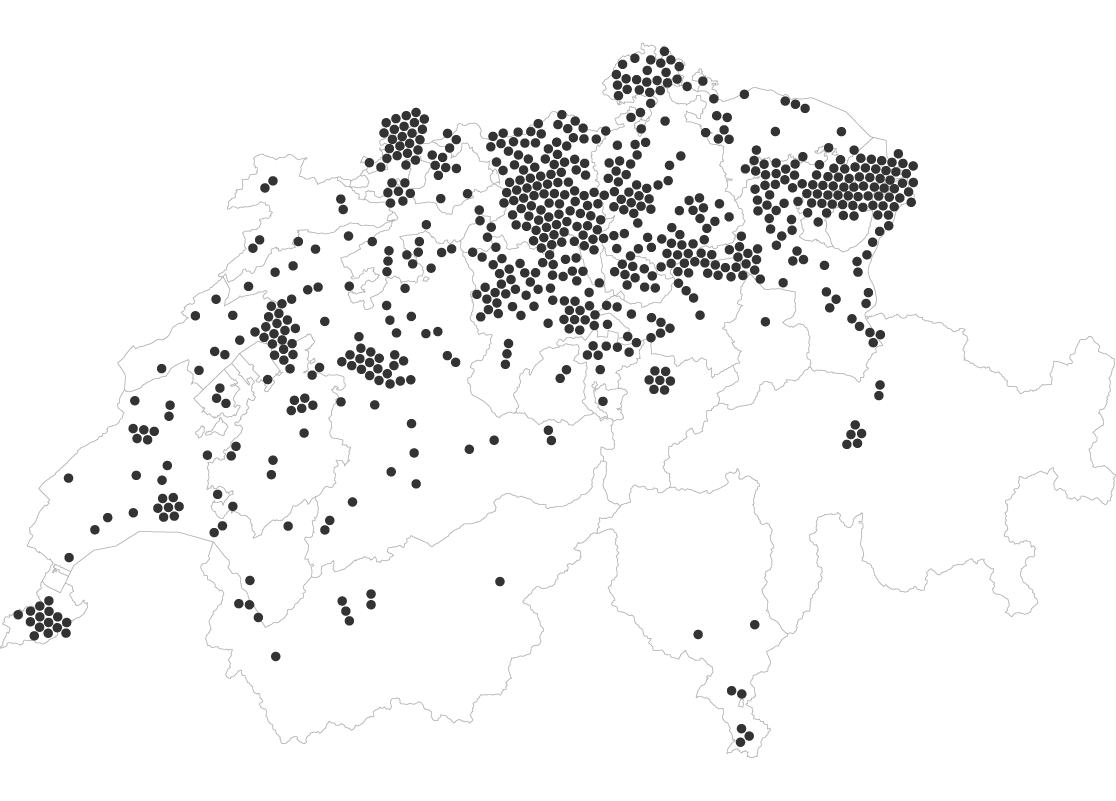
The following types of detention facilities were in operation in Switzerland: forced labour facilities, labour colonies, juvenile correction facilities, alcoholic rehabilitation facilities, prisons, psychiatric institutions, municipal poorhouses (mentioned only in the 19331933 source), and facilities for persons with special needs. All of these facility types were used for the confinement of administrative detainees. If we focus more closely on the year 19651965, we see that prisons were quite evenly distributed throughout Switzerland, which reflects the fact that most districts operated their own local prisons. On the other hand, juvenile correction homes tended to be located mainly in rural areas. Certain forced labour institutions were established in former swamplands (land improvement areas) and plainlands such as the Seeland (Bellechasse facilities, Witzwil facilities, St. Johannsen, Tannenhof Labour Rehabilitation Home) or the Plain of Orbe region (Plaine de l'Orbe facilities).
Facilities are displayed on 8 different maps depending on their typologies. Click on any typology name to zoom on the corresponding map, then hover or click on any element to reveal further information.
Locations of facilities by typology in 1965
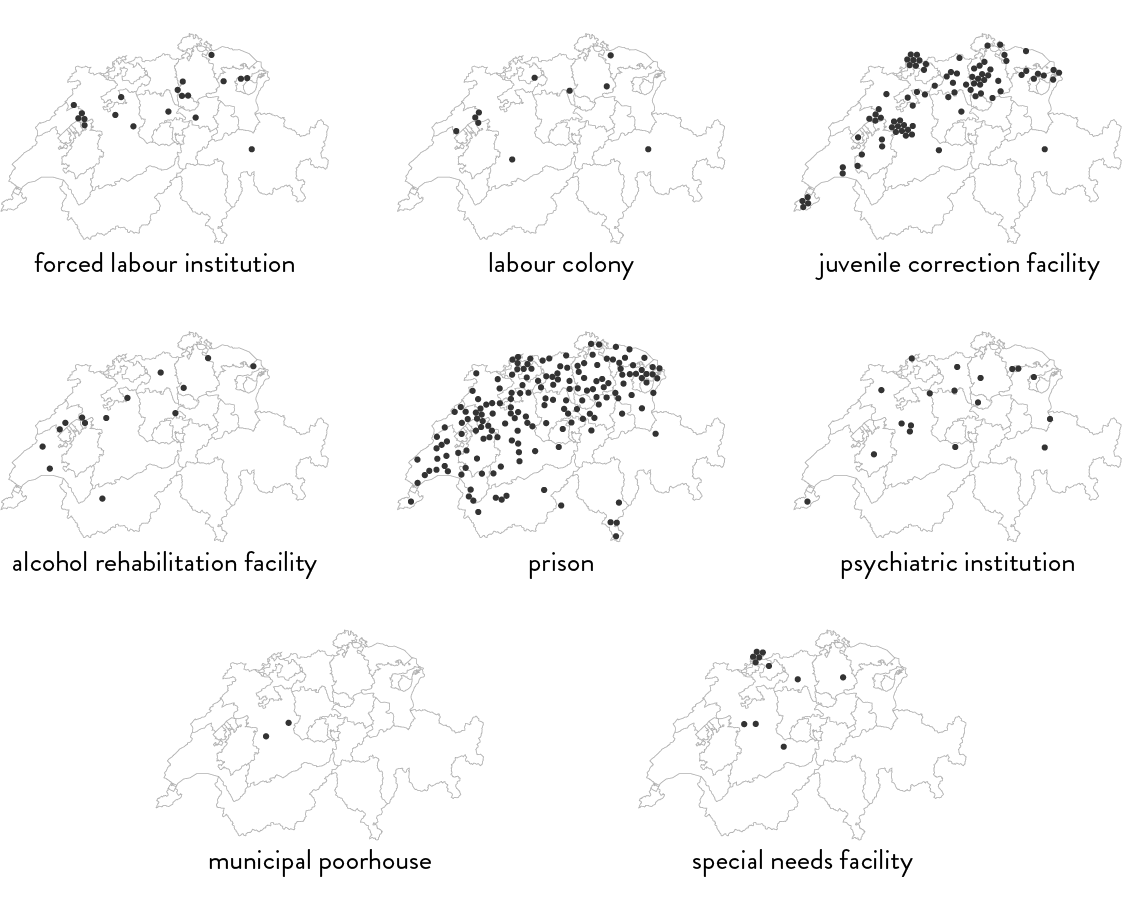
With the help of this map we would like to show the number of places that were available for detainees in the various facilities. This makes it clear that the facilities in operation varied widely in size - from the smallest with a maximum capacity of 19 detainees to larger institutions with capacities of up to 150 inmates and the largest, where 200 or even more individuals could be housed.
The map shows facilities and their respective capacity. hover or click on any element to reveal further information. hover on legend items to highlight corresponding elements.
Taking as an example the year 19541954, and considering solely forced labour institutions, labour colonies and juvenile correction facilities, we see that almost one fifth of the available space for inmates in Switzerland – that is, 1520 places out of a total of some 9000 – was found in just five facilities of the Seeland region: the Bellechasse facilites, the Witzwil facilities, the Tannenhof Labour Rehabilitation Home, St. Johannsen and the Public Correctional Home for Boys in Erlach. Many of the inmates in these institutions were assigned to work in the fields of the plain and thus contributed to the financing of the institution. Today, Witzwil and Bellechasse are two of the largest producers of agricultural products in Switzerland.
Locations of facilities by capacity in 1954
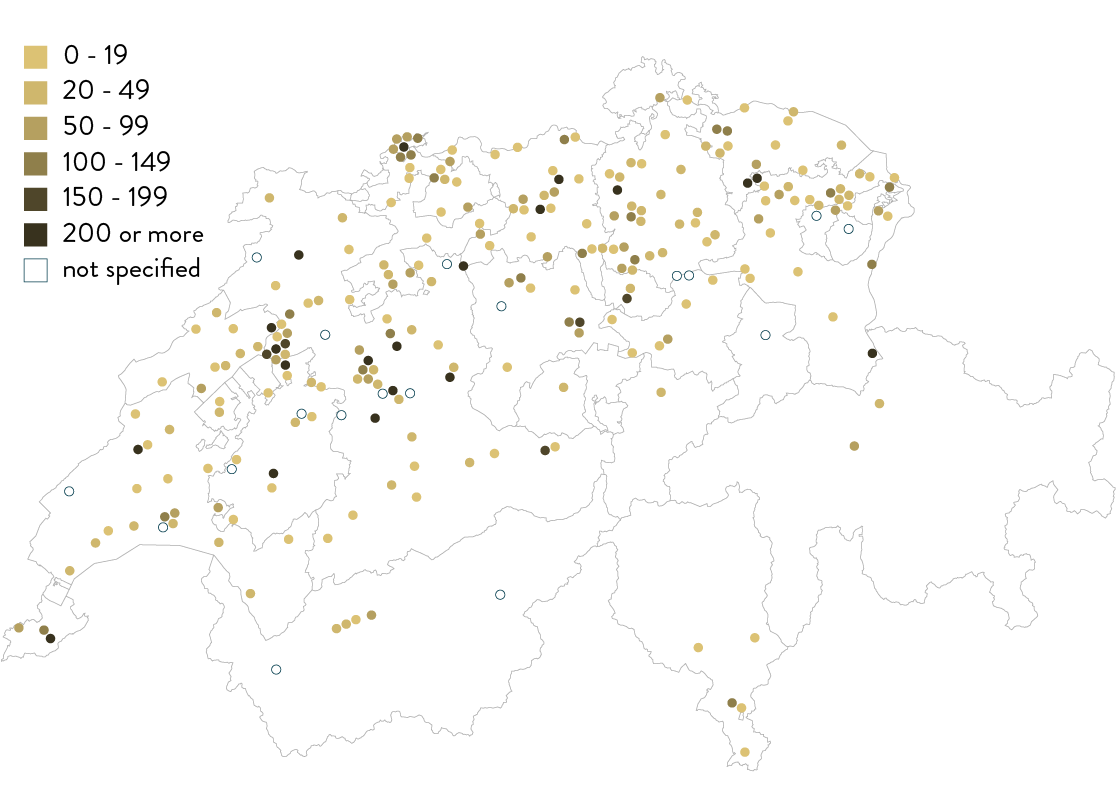
Religious affiliation and gender were two of the main criteria for deciding on the placement of detainees in the facilities. In this chart we distinguish between facilities that were considered to be interdenominational, and those that were predominantly Protestant or Catholic. In poorhouses the religious affiliation of detainees was often unknown. Interdenominational institutions were most likely to be state run and of relatively large size, while Catholic and Protestant facilities tended to be privately funded.
The map shows facilities and their respective religious affiliation. hover or click on any element to reveal more details.
For example, in 19651965 a total of 84 percent of the institutions were interdenominational (the great majority of them being district prisons), while 11 percent were predominantly Catholic and 5 percent predominantly Protestant. Facilities that were restricted to a single religious group were in most cases designed for juvenile correction. Examples of Catholic institutions are the Swiss Girls’ Home in Richterswil (Zurich), the Rathausen Children’s Village (Lucerne), and the Bon Pasteur facility in Lully (Fribourg); examples of Protestant institutions include the Mother and Children’s Home in Lausen (Baselland), the Brüttisellen Rural Home in Bassersdorf (Zurich) and the Kasteln Castle Public Juvenile Home in Oberflachs (Aargau).
Locations of facilities by religious affiliation in 1965
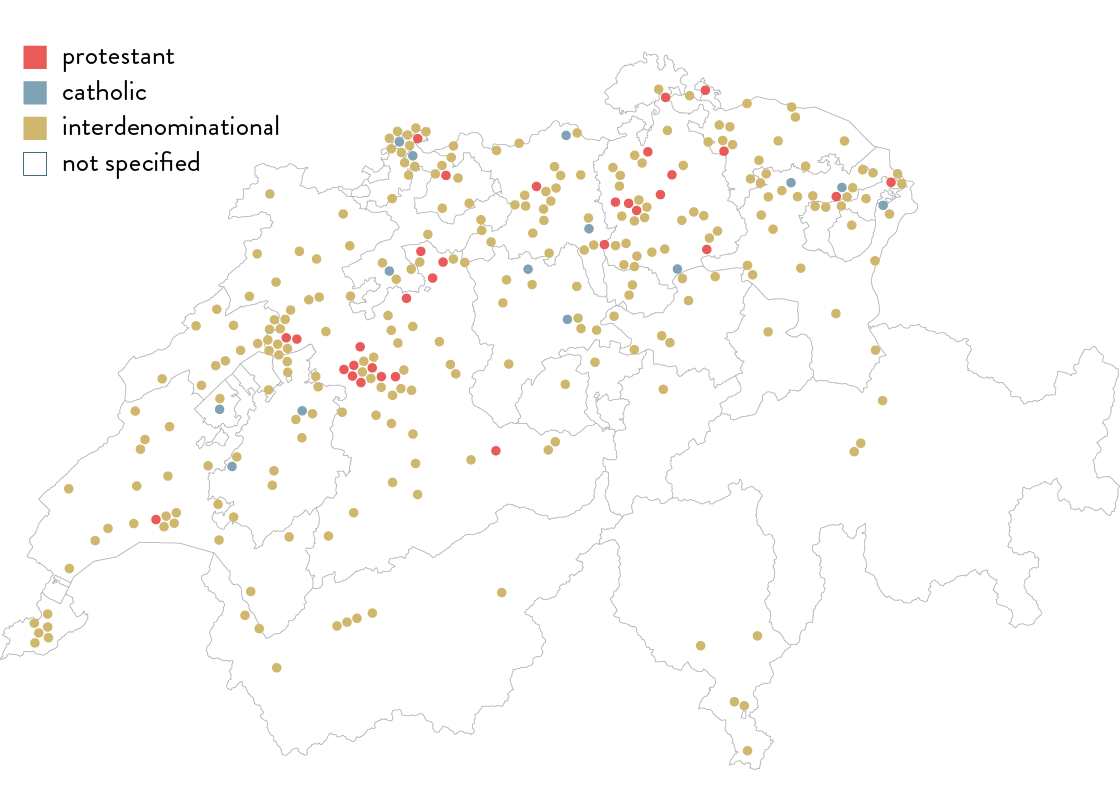
Visualisation 2.4 – Locations of facilities by religious affiliation
Open in a separate window
Gender was the second main criterion considered when deciding where a detainee was to be placed. Continuing on the example of the year 19651965, the map shows that that 59 percent of the facilities were designed for detainees of both genders, while 27 percent were used solely for male detainees and 14 percent solely for female detainees. Many of the facilities used for housing both men and women were district prisons. If we exclude this type of facility from the picture the proportions differ markedly: fully one half of the non-prison facilities were used solely for male detainees, while one fourth were used solely for female detaines; another fourth served to house detainees of both genders combined.
The map shows facilities and their gender ratio. hover or click on any element to reveal more details.
Locations of facilities by accepted gender in 1965
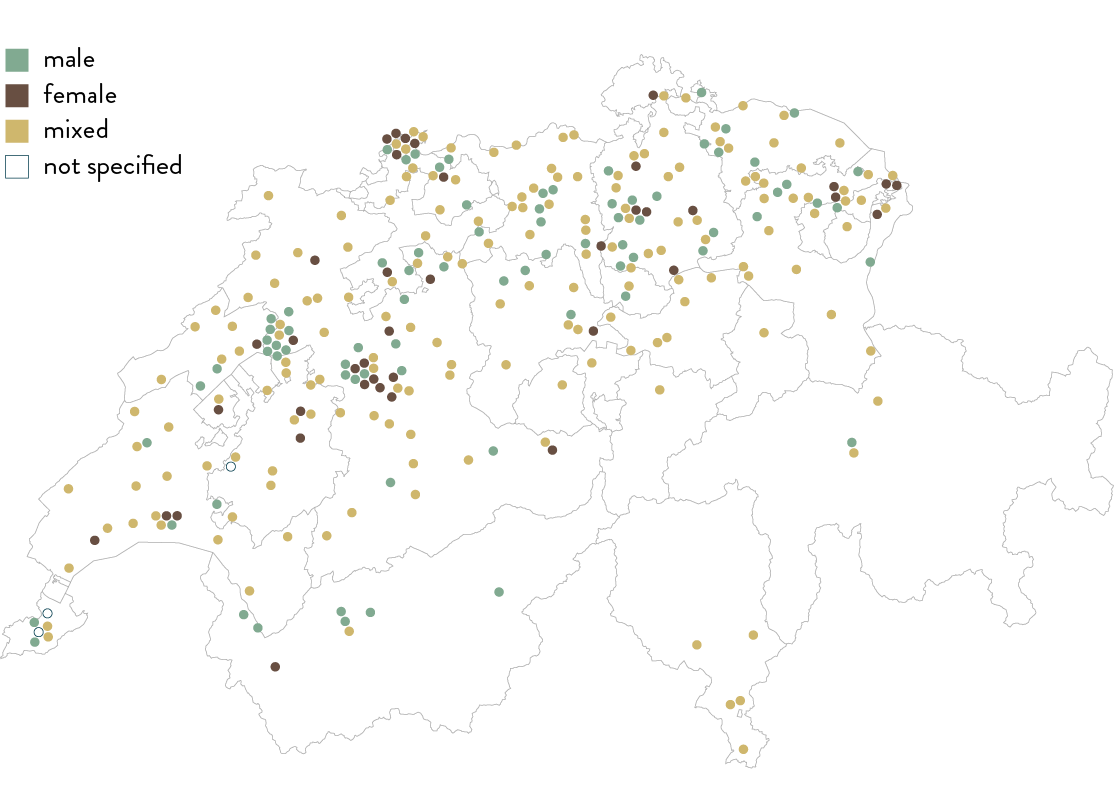
Visualisation 2.5 – Locations of facilities by gender ratio
Open in a separate window
In this chart it is possible to see which features of the various facility types were most often found in combination. The frequency of such combinations is indicated by the size of the coloured circles, which grow in proportion with the number of institutions that evidenced the chosen combination. Thus, because the number of prisons that housed both men and women was relatively largebecause the number of prisons that housed both men and women was relatively large – as noted above – the circle representing such prisons is proportionately large. By contrast, the small size of the circle representing prisons used solely for women graphically illustrates that these types of facilities were relatively rare.
The number of institutions where either only men or women were placed varied among the different types of institutions. Only in the juvenile correction facilites the distribution of single sex institutions have been equal. The administrative detention of adolescents in these institutions usually took place between the age of sixteen and twenty. Already the names of the institutions implied the societal goals of the facilities: the "Anstalt für gefährdete Mädchen Bern-Brunnadern" (girls at risk) or the "Maison d'éducation Bellevue" (house of education) aimed to teach girls and women to be demure and modest, while the purpose of the "Kreckelhof Herisau" or the rural facility "Landerziehungsheim Albisbrunnen" was to accustom young men to work. Coercion to hard work was aimed primarily at men, so that labour colonies had no female equivalent at all, and forced labour institutions specifically targeted at women, such as "Arbeits- und Strafanstalt Hindelbank" or the "Frauenheim Ulmenhof", were the exception.
Correlation matrix: gender ratio and facility types
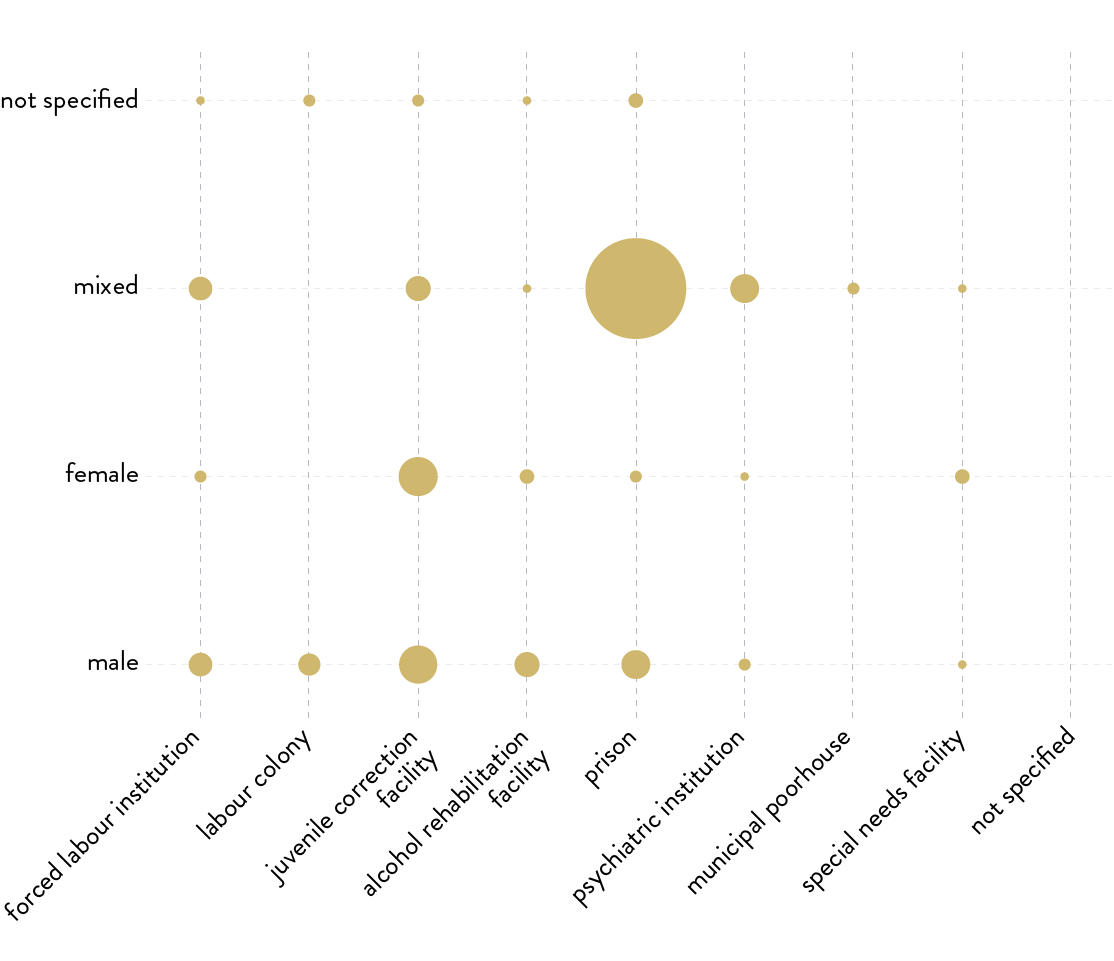
To complete this section, the figure on the side lists the decision-makers involved in the ordering of administrative detentiondecision-makers involved in the ordering of administrative detention, that is, the authorities that had the power to issue such orders. It shows the wide range of official bodies that were involved in the use of the measure: cantonal authorities, the police, guardianship offices, welfare authorities for the poor, etc. The specific bodies responsible for the internment of detainees differed from canton to canton, and from case to case. The chart also makes clear how diffuse the rules on the use of administrative detention in Switzerland actually were.
Correlation matrix: ordering authority and facility types
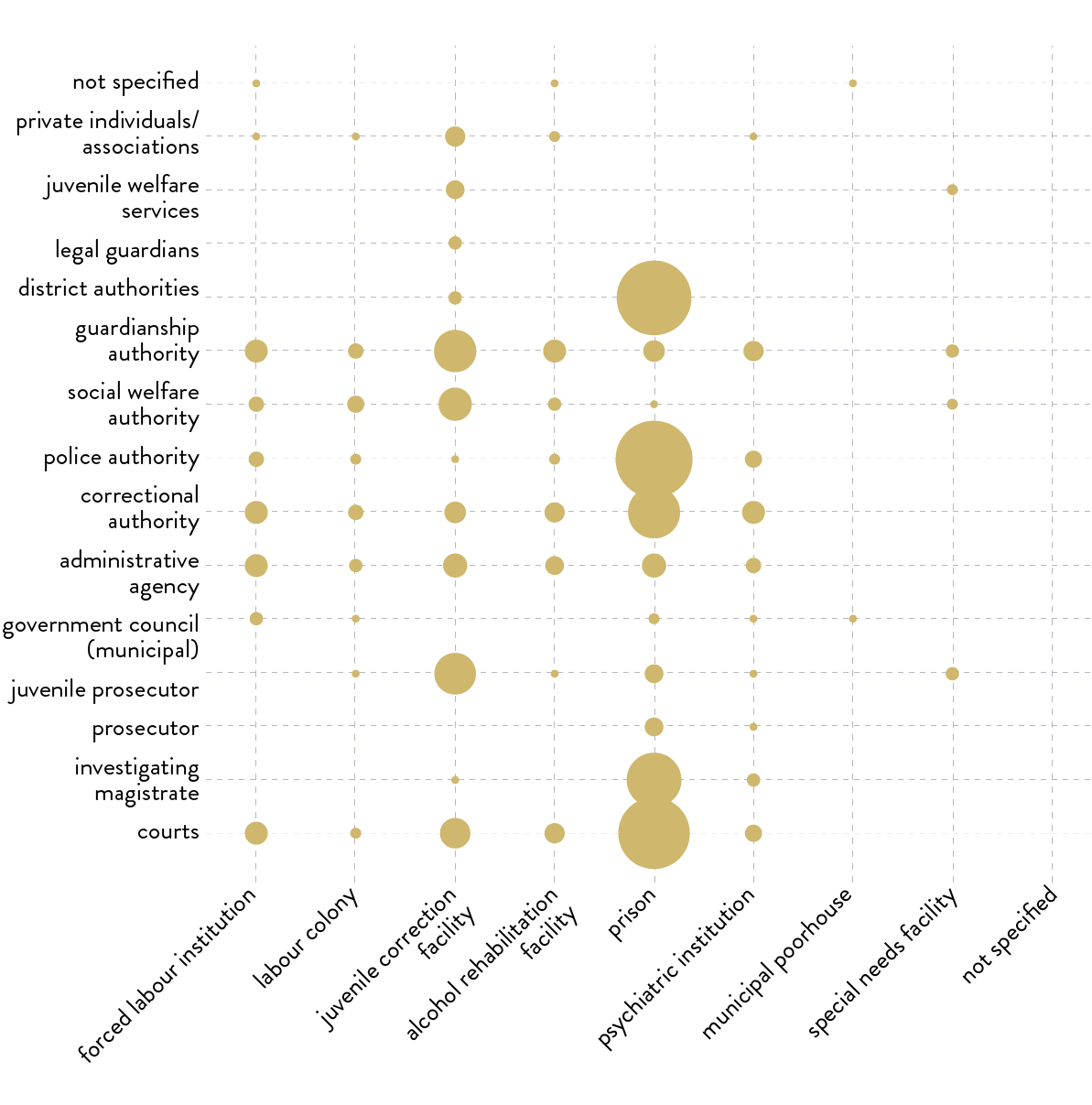
Many other meaningful combinations are to be explored, for instance:
compare capacities and facility types
compare capacities and religious affiliations
Thanks to this chart it is possible to freely compare all facilities properties between each other: use the dropdown menus on the top to switch between them. Click on any circle to reveal a list of corresponding facilities. Switch between survey years by using the menu on top of the visualisation.
In Switzerland, the procedures for ordering administrative detention were based on a heterogeneous and complex set of cantonal statutes and on the Swiss Civil Code. Each Canton developed its own procedures and designated the responsible authorities at the local, regional and cantonal levels. Because of this, the process leading to administrative detention could take many different forms.
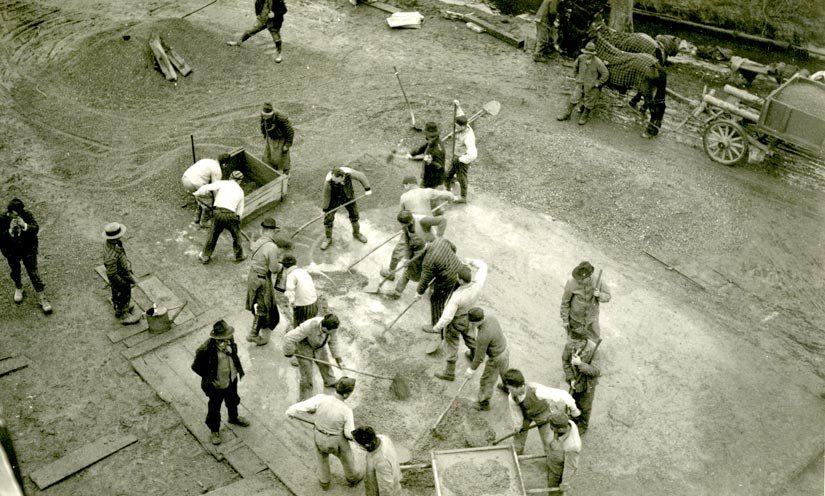
Img. 4.1 – State Archive of the Canton of Fribourg (StAF), EB Div Photos 13, Bellechasse, old colony, forced labour institution, January 20th, 1938, Section V, image 1 : «slab of the attic».
For example in the Canton of Fribourg, as shown in the articles 30 to 43 of the Loi sur l"assistance from July 17th 1951, the various detention measures were decided upon, for the most part, by the prefect, who represented the government in his district and was responsible for maintaining public order. This kind of procedure was subject to few formal requirements and was often carried out in summary fashion. Although there was a requirement that the prefect first conduct an investigation, he normally relied entirely on statements made by the police and other public authorities. The decision on whether to order administrative detention was made by the prefect alone. The rights accorded to the individual in question for being heard or for appealing the decision were minimal. Citizens of the Canton of Fribourg were normally detained in the Bellechasse correctional facilities. Those facilities were also used, however, to house detainees from other Swiss cantons. The execution of administrative detention orders outside the territory of the canton where they were issued, was made possible through agreements between the different cantonal governments. The network of connections that existed between the various cantons for purposes of administrative detention can be seen in the following chart.
This chart shows which cantons worked in cooperation with each other for dealing with administrative detention matters (e.g., which cantons ordered the administrative detention of their own citizens at the Bellechasse facilities in the canton of Fribourg). In some cases the sources do not offer sufficient information to determine where a detention order was ultimately executed. These cases have been marked "unknown". Another interesting feature of this chart is that it shows the existence of intercantonal connections that differed from those later agreed on in the Intercantonal Convention on Criminal Correction. This cooperation between the cantons provided them with the means for executing administrative detention orders even if they did not operate detention facilities on their own territory (such as the canton of Nidwalden, for example).
The chart below represents detainees exchanges between cantons. Click on a circle to highlight the excanges in which the corresponding canton had been involved. double-click on it to show the list of involved facilities.
Network between cantons
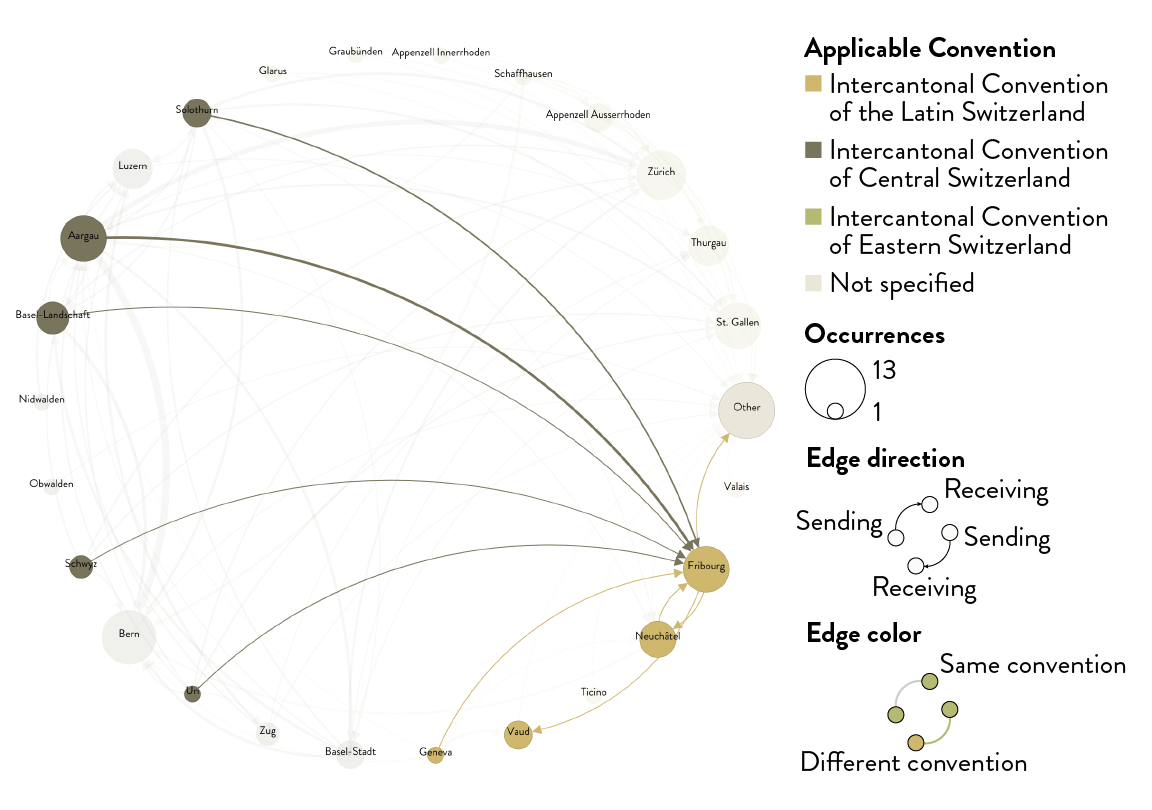
The map below shows the interconnections between the cantons. It is possible to select any given canton and see the links it maintained with other cantons. In addition, it also shows the respective partner institutions that the cantonal administrations chose to work with.
In the canton of Friborg, in 1954, there were apart from the two big institutions Etablissements psychiatrique de Marsens and the Institutions Bellechasse, also the Institute Bon Pasteur in Lully and Villars-Les-Joncs for Catholic girls, as well as the Institute St. Nicolas for Catholic boys and girls. Nevertheless, individuals were placed in institutions across the cantonal borders: young girls in the Maison d'éducation Bellevue in the canton of Neuchâtel and young men in the Institut Romand d'Education in the canton of Vaud.
Accepting institutions into Fribourg in 1954
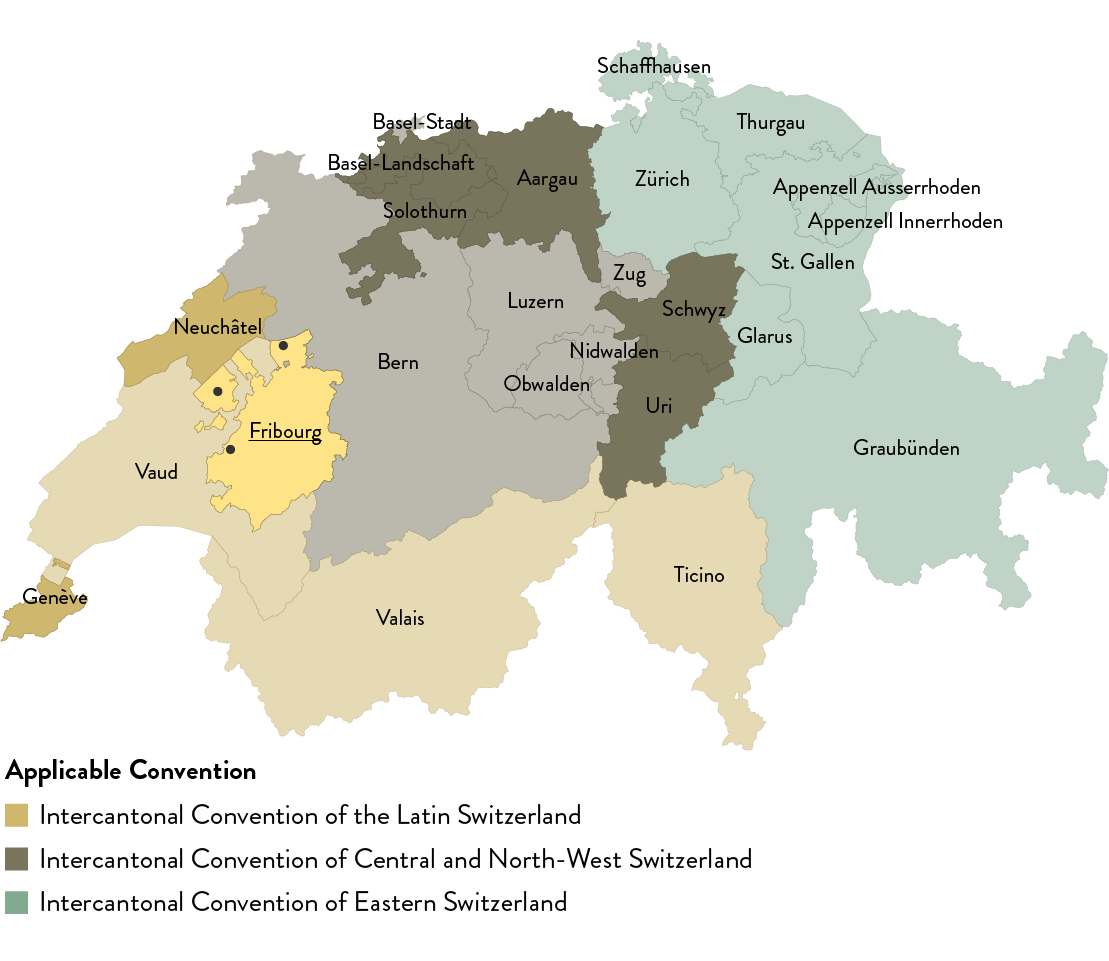
If one looks at the canton of Geneva, which had a prison and a foyer for men in addition to a psychiatric facility, the situation is different: Geneva detained people not only in the neighboring canton of Vaud, but also in the more remote cantons of Bern (Kantonale Zwangserziehungsanstalt Tessenberg) and Aargau (Staatliche Zwangserziehungsanstalt Aarburg) administratively. These two institutions were assigned for young men, the Colonie pénitentiaire de Rolle or the Maison d'éducation Bellevue, however, intended for the education of young women. The canton of Geneva thus relied on this intercantonal network in the area of re-education and the execution of sentences and measures (e.g. Anstalten Bellechasse).
The map represents the relationships of exchanges between a selected canton and all the facilities located outside of it. A relationship existed if detainees were sent from a canton to an external facility, but unfortunately we do not know the size of this phenomenon, which is to say, how many people had been forced to move. If a relationship is represented it means that there had been at least one exchange.
Click on a canton to see related facilities.
Use the menu on top of the map to switch between facilities that are accepting detainees from a particular canton or facilities located into a particular canton that are accepting detainees from outside.
Switch between years and click on any circle to reveal more information in the side panel.
Intercantonal Convention of the Latin Switzerland
Intercantonal Convention of Eastern Switzerland
Intercantonal Convention of Central and North-West Switzerland
Housing detainees
Other facilities
What were the possibilities for administrative detainees to be released from detention? How was the determination made that the goal of "(re-)education" – the ostensible purpose of administrative detention – had been achieved? Who decided when a detainee was to be released? Was an administrative detainee really free when he or she left the detention facility? These are the issues covered by the section on release practices.
Release from detention could be ordered either unconditionally or subject to probation. For example, during the 1920s, a detainee seeking early release from the Sapinière correctional labour facility for alcoholics – one of the various detention facilities in Bellechasse, Canton of Fribourg – was required to obtain the approval of the facility director. The latter’s expert assessment was considered crucial for establishing the detainees’ "recovery performance".
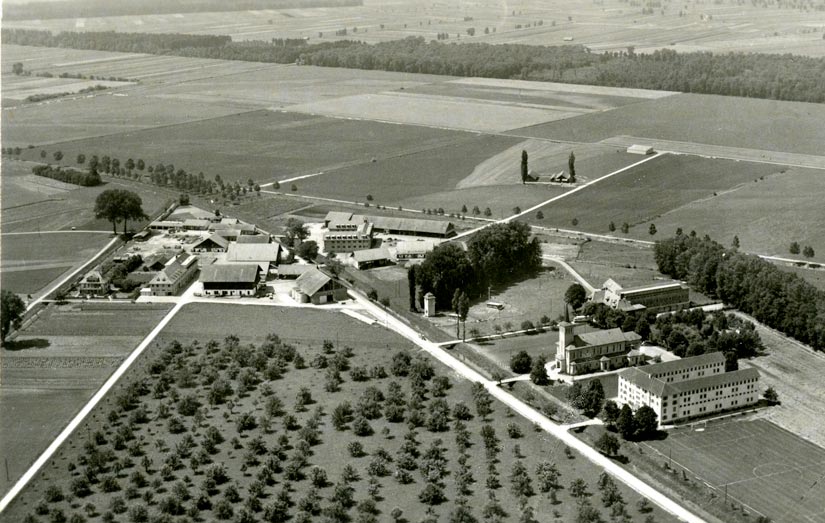
Img. 4.2 – State Archive of the Canton of Fribourg (StAF), EB Div Photos 10 II, Bellechasse, «aerial view of Bellechasse», 1956-1972. [Photographer: B. Bachmann, Bern]
As a result, there was heavy pressure on the detainees to comply with all rules and to fulfil all other expectations imposed on them in terms of work and conduct during the period of their detention. Release on probation, as a transitional phase between detention and freedom was subject to various conditions – and this not only in Bellechasse and not only during the 1920s – concerning their conduct during the probation period (abstinence from alcohol, for example, or a prohibition on entering places where alcohol is served). Inmates released on probation were kept under surveillance by local authorities or agents of the supervision authority. Failure to abide by the conditions of their release placed them at risk of being returned to detention. The number of cases in which people were repeatedly placed in detention provides an indication of how difficult it was to avoid surveillance.
In the period from 1930 to 1980 there were more than 640 institutions used by cantonal, municipal and non-governmental bodies for confining individuals under administrative detention orders. The sources consulted provide a wealth of information on the different types of institutions that were used and the geographical and temporal context in which they were operated. By highlighting the relations between the various authorities and corresponding institutions in neighbouring cantons, it has been possible to identify an administrative network that operated beyond cantonal and judicial borders – a notable example being the intercantonal use of the Bellchasse correctional facilities in Fribourg. This multilateral cooperation at the cantonal level developed long before it was officialised in the intercantonal conventions that were signed between the 1960s and the mid-1970s (and under which a few key institutions were designated for the purpose of housing detainees from all the participating cantons).
For the first time, it is now possible to obtain a full overview of the detention facilities in operation in Switzerland during the period in question, properly identified and marked on a map, together with supplementary information. The glossary section provides a wide range of documentation for a thorough – though certainly not exhaustive – study of the cantonal laws and institutions that played a central role in this chapter of Swiss history. A quantitative approach to the study of this specific compulsory measure offers a deeper understanding of how the institutional landscape was constructed, and how it developed and functioned. The data visualizations also illustrate the research process, as it proceeds from the raw historical sources towards initial research results, which in turn raise further questions for investigation. Answers to those questions will be found in the upcoming publications of the Independent Expert Commission.
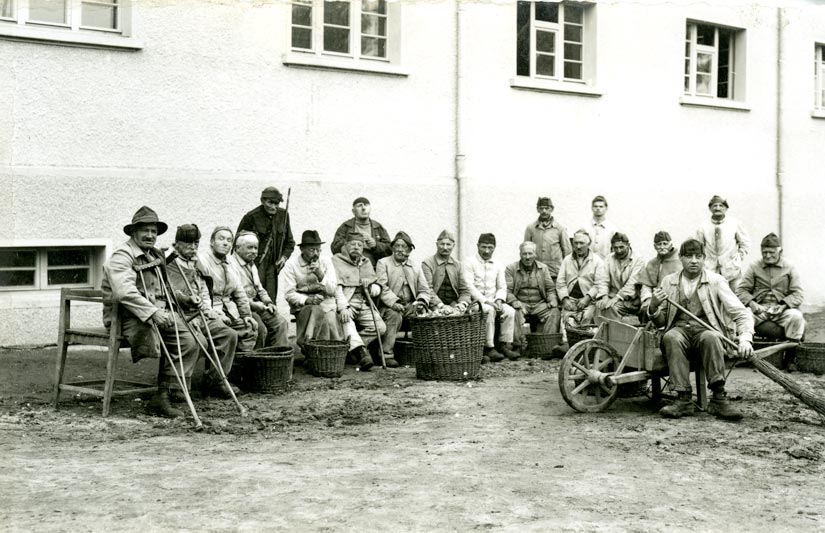
Img. 4.3 – Archives de l'Etat de Fribourg (AEF)/Staatsarchiv Freiburg (StAF), EB Div Photos 24, Bellechasse, ”un groupe d'assistés“, 1920-1930. [Photographe: Simon Glasson, Bulle]
“Switzerland's institutional landscape 1933–1980” is a project designed and developed by the Independent Expert Commission (IEC) and the DensityDesign Research Lab (DD): Andrea Benedetti (DD), Paolo Ciuccarelli (DD), Marco Dal Molin (IEC), Tommaso Elli (DD), Ernst Guggisberg (IEC), Michele Invernizzi (DD), Michele Mauri (DD), Joséphine Métraux (IEC)
Data collection and analysis: Marco Dal Molin, Nicole Gönitzer, Ernst Guggisberg, Deborah Morat
Texts: Marco Dal Molin, Nicole Gönitzer, Ernst Guggisberg, Mirjam Häsler, Matthieu Lavoyer, Joséphine Métraux